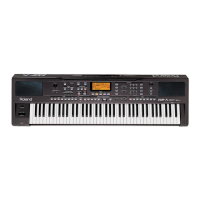
Do you have a question about the Roland EXR-7 and is the answer not in the manual?
| Brand | Roland |
|---|---|
| Model | EXR-7 |
| Category | Electronic Keyboard |
| Language | English |
Details the EXR-7's sound generation capabilities, including waveforms and polyphony.
Covers essential safety instructions for using the unit to prevent injury or damage.
Covers power supply, placement, and interference considerations for optimal performance.
Details all input/output jacks and ports on the rear panel (A-E).
Step-by-step guide for connecting the power adapter and turning on the instrument.
Explains PIANO SOLO mode, its limitations, and how to use the Main part.
Guides on starting, using, and controlling the Arranger accompaniment.
Covers selecting styles from various memory areas and managing them.
Explains how to program and play back recorded loops using markers.
Details how to mute parts for live performance accompaniment practice.
Describes how to vary accompaniment complexity using the Band Orchestrator.
Step-by-step guide for recording songs with Arranger backing.
Explains the different recording modes: ALL, Keyboard, Single, and Punch I/O.
Details specific procedures for Single and Punch I/O recording.
Explains how the Music Assistant helps set up Arranger parameters for songs.
Details the Melody Intelligence feature for adding harmony to melodies.
Explains keyboard velocity sensitivity and how to adjust touch response.
Explains the D BEAM controller's functions and how to assign effects like DJ GEAR, EFX, and CONTROLS.
Details how to use Reverb, Chorus, and Multi-Effects processors, including settings and combinations.
Guides on writing, selecting, and saving User Programs to memory.
Instructions for backing up and transferring data using a USB connection to a computer.
Step-by-step guide to reset the EXR-7 to its original factory settings.
